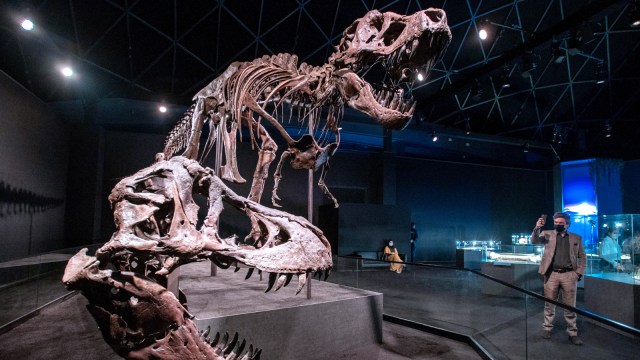Near complete T-Rex skeleton, Blue whale specimen: Abu Dhabi Natural History Museum to open on Nov 22
Natural History Museum Abu Dhabi has a wide range of exhibits which will take visitors on an immersive journey through 13.8 billion years of natural history.
 Stan, a nearly complete skeleton of a mighty Tyrannosaurus rex will be the star attraction. (Photo: Abu Dhabi Media Office)
Stan, a nearly complete skeleton of a mighty Tyrannosaurus rex will be the star attraction. (Photo: Abu Dhabi Media Office) One of the most anticipated projects in the Middle East, the Natural History Museum in Abu Dhabi, is all set to welcome visitors. Natural History Museum Abu Dhabi on Tuesday announced that it will open its doors on November 22.
Natural History Museum, Abu Dhabi
Located in the Saadiyat Cultural District, the 35,000-square-metre Natural History Museum Abu Dhabi has a wide range of exhibits which will take visitors on an immersive journey through 13.8 billion years of natural history – from the Big Bang and the formation of our solar system to the evolution of life, including the rise and fall of dinosaurs and the extraordinary biodiversity of the planet.

A journey through time
The museum features a series of permanent galleries and exhibitions that take visitors on a journey through time. The main galleries include: The Story of Earth, The Evolving World, Our World, Resilient Planet, and Earth’s Future, alongside side galleries such as The PalaeoLab, The Life Sciences Lab, Arabia’s Climate, Beyond the Horizon, and The Human Story.
Key attractions
According to the Natural History Museum Abu Dhabi, the most notable exhibits include a specimen affectionately known as Stan, a nearly complete skeleton of a mighty Tyrannosaurus rex, an apex predator that ruled the Earth 67 million years ago.

Another key attraction is the largest animal ever known, represented by a magnificent, 25-metre female blue whale specimen, offering extraordinary insight into evolution, marine biodiversity, and the planet’s ongoing story of life.
Also on display at the Natural History Museum Abu Dhabi is the Murchison Meteorite – an artefact that witnessed the formation of planet Earth and contains 7-billion-year-old grains formed even before the Solar System.
Natural history of Arabian Peninsula
It will also be the home to exhibits showing the natural history of the Arabian Peninsula. Among the most remarkable discoveries found in Abu Dhabi is an extinct species of elephant known as Stegotetrabelodon emiratus. This ancient member of the Elephantidae family was distinguished by tusks in both its upper and lower jaws — a rare trait unseen in modern elephants — offering visitors a glimpse into the evolutionary journey of these creatures and reflecting the region’s rich natural heritage.

Grand opening
To mark its opening, the museum will present two temporary international exhibitions: The March of the Triceratops, showcasing the world’s only touring Triceratops herd, and the 61st Wildlife Photographer of the Year, one of the most prestigious global showcases of nature photography.
“The museum offers an immersive look at the story of life on Earth, framed for the first time through an Arabian lens, with the fauna, flora, and geological history of the region forming a prominent part of the visitor journey,” Mohamed Khalifa Al Mubarak, Chairman of the Department of Culture and Tourism, Abu Dhabi, said.
“The museum’s research and educational institution supports scientific knowledge and undertakes innovative scientific studies in zoology, palaeontology, marine biology, molecular research and earth sciences,” he added.







